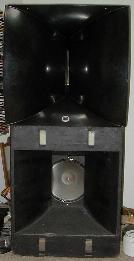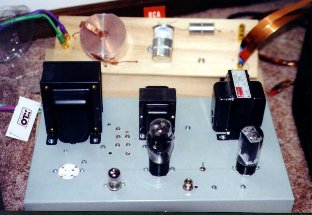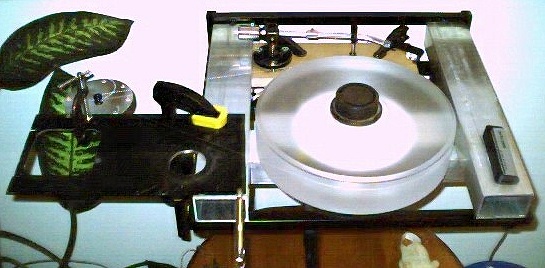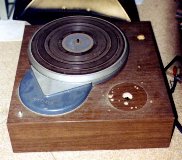Welcome to Roscoe Primrose's DIY Systems Page!
![]()
![]()
The current system represents the results of hours and hours of listening to different combinations of drivers, horns, amps, crossovers etc. It probably won't stay like this for long either, but this is a good snapshot. Listening room is 15'x17' with a cathedral ceiling.
The current system consists of a Teres DIY turntable with an original (not S2 or improved) SME 3009 tonearm, Ortofon SPU Classic GM low output MC. Phono amplification consists of a Denon AU-320 MC step-up transformer into a DIY DIY interstage transformer coupled phono stage. Digital source is a Theta Digital Bata Basic II, fed into a DIY non-oversampled DAC. Amplification consists of either direct coupled 26-45 amps or IT coupled SE 845 amps. Crossover is first order at 780Hz. Speakers consist of Altec small-frame 515Bs in JBL 4560 (JBL's answer to the Altec 825/828 cabs, the Altecs are a bit bigger, and I think they do better below the horn cutoff, but the JBLs have an exponential (rather than radiused) flare and are better built) cabinets for bass, and JBL 2441s with 2440 diaphragms on JBL 2360A horns for highs.
 Seen closup, the HF horn seems huge, and it is. It took me almost two years to find a pair of these HF horns (that I could afford anyway, JBL still makes them according to their website) and I ended up having to get four of them (for about the price of one new one) in order to get them. In my system, these seem much better than the Altec 803Bs with 288Bs or 288Ks.
Seen closup, the HF horn seems huge, and it is. It took me almost two years to find a pair of these HF horns (that I could afford anyway, JBL still makes them according to their website) and I ended up having to get four of them (for about the price of one new one) in order to get them. In my system, these seem much better than the Altec 803Bs with 288Bs or 288Ks.
 Close-up view of an eairlier version the right 45 amp, a 5842 direct coupled to either a 2A3 or 45, Single Ended. Rectifier is a 5AR4. Amps are on about revision 60, they started life as 2A3 monoblocks, capacitor coupled. I tried interstage transformer coupleing with some inexpensive ($15US) Allied Electronics ITs, and even with the el-cheapo ITs it was still a huge step up from the Audio Note paper in oil coupling caps I had been using. I also tried using a 26 is a driver, with an IT with a 3:1 stepup ratio to get the required voltage gain, but I could never get the 26 quiet enough to use. Next I tried direct coupling, which was another step up. I still want to try IT coupling again sometime with decent ITs, but I've got other things to spend my money on for now. I swapped back and forth between 2A3s and 45s several times, with each different coupling scheme, also tried each with the old stock 2A3 monoplates I have. In every case I liked the 2A3 monoplates the best, but I've only got three, and they're too expensive. I'm currently using 45s most of the time.
Close-up view of an eairlier version the right 45 amp, a 5842 direct coupled to either a 2A3 or 45, Single Ended. Rectifier is a 5AR4. Amps are on about revision 60, they started life as 2A3 monoblocks, capacitor coupled. I tried interstage transformer coupleing with some inexpensive ($15US) Allied Electronics ITs, and even with the el-cheapo ITs it was still a huge step up from the Audio Note paper in oil coupling caps I had been using. I also tried using a 26 is a driver, with an IT with a 3:1 stepup ratio to get the required voltage gain, but I could never get the 26 quiet enough to use. Next I tried direct coupling, which was another step up. I still want to try IT coupling again sometime with decent ITs, but I've got other things to spend my money on for now. I swapped back and forth between 2A3s and 45s several times, with each different coupling scheme, also tried each with the old stock 2A3 monoplates I have. In every case I liked the 2A3 monoplates the best, but I've only got three, and they're too expensive. I'm currently using 45s most of the time.

My Teres turntable in it's earliest playing state. Don't let the 5 clamps and a pair of Vise Grips holding it together fool you, this table really rocks.
 The more rigid arm mounting, and the change to the SME 3009 made a huge difference in the sound. I can't wait to see what it'll sound like when I build a Ladegaard air bearing tonearm for it. The reason the SME arm looks like it's backwards is that the air bering arm will go across the back.
The more rigid arm mounting, and the change to the SME 3009 made a huge difference in the sound. I can't wait to see what it'll sound like when I build a Ladegaard air bearing tonearm for it. The reason the SME arm looks like it's backwards is that the air bering arm will go across the back.
An earlier DIY turntable project:

On the left, the Rek-o-Kut K-33 turntable that provided the platter and bearing for the turntable I'm in the process of building.
On the right, an in progress view from the top of my DIY turntable. Turntable is a string driven turntable based on a Rek-o-Kut K-33 bearing and platter with a Kenwood direct drive turntable being used as a motor. Plinth is a five layer 3/4" MDF with 1/8" cork and DynaMat used as constrained layer damping. One of these days I'll get around to building a matching plinth/base for the Kenwood motor...